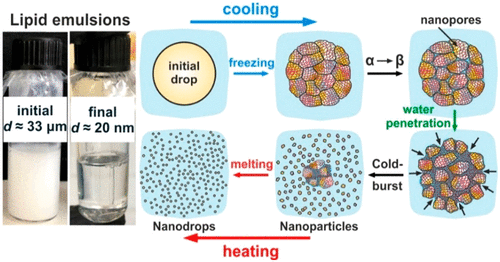Our official English website, www.x-mol.net, welcomes your
feedback! (Note: you will need to create a separate account there.)
Nanopore and Nanoparticle Formation with Lipids Undergoing Polymorphic Phase Transitions.
ACS Nano ( IF 15.8 ) Pub Date : 2020-07-01 , DOI: 10.1021/acsnano.0c02946 Diana Cholakova 1 , Desislava Glushkova 1 , Slavka Tcholakova 1 , Nikolai Denkov 1
ACS Nano ( IF 15.8 ) Pub Date : 2020-07-01 , DOI: 10.1021/acsnano.0c02946 Diana Cholakova 1 , Desislava Glushkova 1 , Slavka Tcholakova 1 , Nikolai Denkov 1
Affiliation

|
We describe several unexpected phenomena, caused by a solid–solid phase transition (gel-to-crystal) typical for all main classes of lipid substances: phospholipids, triglycerides, diglycerides, alkanes, etc. We discovered that this transition leads to spontaneous formation of a network of nanopores, spreading across the entire lipid structure. These nanopores are spontaneously impregnated (flooded) by water when appropriate surfactants are present, thus fracturing the lipid structure at a nanoscale. As a result, spontaneous disintegration of the lipid into nanoparticles or formation of double emulsions is observed, just by cooling and heating of an initial coarse lipid-in-water dispersion around the lipid melting temperature. The process of nanoparticle formation is effective even after incorporation of medical drugs of high load, up to 50% in the lipid phase. The role of the main governing factors is clarified, the procedure is optimized, and the possibility for its scaling-up to industrially relevant amounts is demonstrated.
中文翻译:

纳米孔和纳米粒子与脂质经历多态相变的形成。
我们描述了几种意外的现象,这些现象是由所有主要类别的脂质物质的典型固-固相变(凝胶到晶体)引起的:磷脂,甘油三酸酯,甘油二酸酯,烷烃等。我们发现,这种转变导致纳米孔网络的自发形成,并遍布整个脂质结构。当存在适当的表面活性剂时,这些纳米孔会被水自然浸渍(淹没),从而使脂质结构在纳米级破裂。结果,仅通过在脂质熔化温度附近冷却和加热初始的粗的水包脂质分散体,观察到脂质自发崩解成纳米颗粒或形成双重乳液。即使在脂质相中掺入高达50%的高载量药物之后,纳米颗粒的形成过程仍然有效。阐明了主要控制因素的作用,优化了程序,并证明了将其扩大到与工业相关的量的可能性。
更新日期:2020-07-28
中文翻译:

纳米孔和纳米粒子与脂质经历多态相变的形成。
我们描述了几种意外的现象,这些现象是由所有主要类别的脂质物质的典型固-固相变(凝胶到晶体)引起的:磷脂,甘油三酸酯,甘油二酸酯,烷烃等。我们发现,这种转变导致纳米孔网络的自发形成,并遍布整个脂质结构。当存在适当的表面活性剂时,这些纳米孔会被水自然浸渍(淹没),从而使脂质结构在纳米级破裂。结果,仅通过在脂质熔化温度附近冷却和加热初始的粗的水包脂质分散体,观察到脂质自发崩解成纳米颗粒或形成双重乳液。即使在脂质相中掺入高达50%的高载量药物之后,纳米颗粒的形成过程仍然有效。阐明了主要控制因素的作用,优化了程序,并证明了将其扩大到与工业相关的量的可能性。











































 京公网安备 11010802027423号
京公网安备 11010802027423号